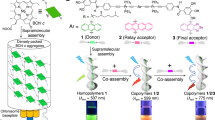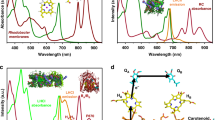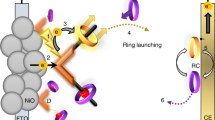Abstract
Naturally occurring photosynthetic systems use elaborate pathways of self-repair to limit the impact of photo-damage. Here, we demonstrate a complex consisting of two recombinant proteins, phospholipids and a carbon nanotube that mimics this process. The components self-assemble into a configuration in which an array of lipid bilayers aggregate on the surface of the carbon nanotube, creating a platform for the attachment of light-converting proteins. The system can disassemble upon the addition of a surfactant and reassemble upon its removal over an indefinite number of cycles. The assembly is thermodynamically metastable and can only transition reversibly if the rate of surfactant removal exceeds a threshold value. Only in the assembled state do the complexes exhibit photoelectrochemical activity. We demonstrate a regeneration cycle that uses surfactant to switch between assembled and disassembled states, resulting in an increased photoconversion efficiency of more than 300% over 168 hours and an indefinite extension of the system lifetime.
This is a preview of subscription content, access via your institution
Access options
Subscribe to this journal
Receive 12 print issues and online access
$259.00 per year
only $21.58 per issue
Buy this article
- Purchase on Springer Link
- Instant access to full article PDF
Prices may be subject to local taxes which are calculated during checkout







Similar content being viewed by others
References
Aro, E. M., Virgin, I. & Andersson, B. Photoinhibition of photosystem II. Inactivation, protein damage and turnover. Biochim. Biophys. Acta—Bioenerg. 1143, 113–134 (1993).
Melis, A. Dynamics of photosynthetic membrane composition and function. Biochim. Biophys. Acta—Bioenerg. 1058, 87–106 (1991).
Richard, C., Balavoine, F., Schultz, P., Ebbesen, T. W. & Mioskowski, C. Supramolecular self-assembly of lipid derivatives on carbon nanotubes. Science 300, 775–778 (2003).
Bayburt, T. H., Grinkova, Y. V. & Sligar, S. G. Self-assembly of discoidal phospholipid bilayer nanoparticles with membrane scaffold proteins. Nano Lett. 2, 853–856 (2002).
Jones, M. R. The petite purple photosynthetic powerpack. Biochem. Soc. Trans. 37, 400–407 (2009).
Hoff, A. J. & Deisenhofer, J. Photophysics of photosynthesis. Structure and spectroscopy of reaction centers of purple bacteria. Phys. Rep.—Rev. Sec. Phys. Lett. 287, 1–247 (1997).
Arnold, M. S., Green, A. A., Hulvat, J. F., Stupp, S. I. & Hersam, M. C. Sorting carbon nanotubes by electronic structure using density differentiation. Nature Nanotech. 1, 60–65 (2006).
Denisov, I. G., McLean, M. A., Shaw, A. W., Grinkova, Y. V. & Sligar, S. G. Thermotropic phase transition in soluble nanoscale lipid bilayers. J. Phys. Chem. B 109, 15580–15588 (2005).
Ponder, J. W. & Case, D. A. Force fields for protein simulation. Adv. Protein Chem. 66, 27–85 (2003).
Hu, L., Hecht, D. S. & Gruner, G. Percolation in transparent and conducting carbon nanotube networks. Nano Lett. 4, 2513–2517 (2004).
Ham, M. H., Kong, B. S., Kim, W. J., Jung, H. T. & Strano M. S. Unusually large Franz–Keldysh oscillations at ultraviolet wavelengths in single-walled carbon nanotubes. Phys. Rev. Lett. 102, 047402 (2009).
Agostiano, A., Caselli, M., Cosma, P. & Monica, M. D. Electrochemical investigation of the interaction of different mediators with the photosynthetic reaction center from Rhodobacter sphaeroides. Electrochim. Acta 45, 1821–1828 (2000).
Trammell, S. A., Spano, A., Price, R. & Lebedev, N. Effect of protein orientation on electron transfer between photosynthetic reaction centers and carbon electrodes. Biosens. Bioelectron. 21, 1023–1028 (2006).
Trammell, S. A., Wang, L., Zullo, J. M., Shashidhar, R. & Lebedev, N. Orientated binding of photosynthetic reaction centers on gold using Ni-NTA self-assembled monolayers. Biosens. Bioelectron. 19, 1649–1655 (2004).
Khairnar, U. P., Bhavsar, D. S., Vaidya, R. U. & Bhavsar, G. P. Optical properties of thermally evaporated cadmium telluride thin films. Mater. Chem. Phys. 80, 421–427 (2003).
Zhao, J. et al. Photoelectrochemistry of photosynthetic reaction centers embedded in Al2O3 gel. J. Photochem. Photobiol. A 152, 53–60 (2002).
Kalabina, N. A., Zaitsev, S. Y., Zubov, V. P., Lukashev, E. P. & Kononenko, A. A. Polymer ultrathin films with immobilized photosynthetic reaction center proteins. Biochim. Biophys. Acta—Biomembr. 1284, 138–142 (1996).
Sommeling, P. M., Spath, M., Smit, H. J. P., Bakker, N. J. & Kroon, J. M. Long-term stability testing of dye-sensitized solar cells. J. Photochem. Photobiol. A 164, 137–144 (2004).
Kuang, D. et al. Stable, high-efficiency ionic-liquid-based mesoscopic dye-sensitized solar cells. Small 3, 2094–2102 (2007).
Wang, M. et al. Efficient and stable solid-state dye-sensitized solar cells based on a high-molar-extinction-coefficient sensitizer. Small 6, 319–324 (2010).
Biancardo, M., West, K. & Krebs, F. C. Quasi-solid-state dye-sensitized solar cells: Pt and PEDOT:PSS counter electrodes applied to gel electrolyte assemblies. J. Photochem. Photobiol. A 187, 395–401 (2007).
Kermasha, S., Khalyfa, A., Marsot, P., Alli, I. & Fournier, R. Biomass production, purification and characterization of chlorophyllase, from alga (Phaeodactylum tricornutum). Biotechnol. Appl. Biochem. 15, 142–159 (1992).
Voronin, P. Y. et al. Chlorophyll index and annual photosynthetic carbon sequestering in Sphagnum phytocenoses. Russ. J. Plant Physiol. 44, 23–29 (1997).
Melis, A., Neidhardt, J., Baroli, I. & Benemann, J. R. Maximizing photosynthetic productivity and light utilization in microalgae by minimizing the light-harvesting chlorophyll antenna size of the photosystems. In BioHydrogen (ed. Zaborsky, O. R.) 41–52 (Plenum Press, 1998).
Dawson, T. L. Biosynthesis and synthesis of natural colours. Color. Technol. 125, 61–73 (2009).
Moser, S., Muller, T., Oberhuber, M. & Krautler, B. Chlorophyll catabolites—chemical and structural footprints of a fascinating biological phenomenon. Eur. J. Org. Chem. 2009, 21–31 (2009).
Vasilikiotis, C. & Melis, A. The role of chloroplast-encoded protein biosynthesis on the rate of D1 protein degradation in Dunaliella salina. Photosynth. Res. 45, 147–155 (1995).
Goldsmith, J. O. & Boxer, S. G. Rapid isolation of bacteria photosynthetic reaction centers with an engineered poly-histidine tag. Biochim. Biophys. Acta—Bioenerg. 1276, 171–175 (1996).
Takahashi, E. & Wraight, C. A. Proton and electron transfer in the acceptor quinone complex of Rhodobacter sphaeroides reaction centers: characterization of site-directed mutants of the two ionizable residues, GluL212 and AspL213, in the QB binding site. Biochemistry 31, 855–866 (1992).
Acknowledgements
This work was financially supported by a grant from ENI Petroleum Co. Inc. Eni S.p.A. under the Eni–MIT Alliance Solar Frontiers Program, seed funding from the MIT Energy Initiative (MITEI) and the U.S. Department of Energy (grant no. ER46488). M.H.H. is grateful for support from the Korea Research Foundation Grant funded by the Korean Government (MOEHRD) (KRF-2007-357-D00133). J.H.C. acknowledges financial support from Purdue University. Membrane scaffold proteins were produced and initial PSII reconstitution experiments were supported by NIH GM33775.
Author information
Authors and Affiliations
Contributions
M.H.H., J.H.C., A.A.B. and M.S.S. designed the research. M.H.H., J.H.C., A.A.B., R.A.G. and D.A.H. synthesized the complexes. M.H.H. performed the photoelectrochemical experiments. J.H.C. purified the complexes and performed the spectroscopic experiments with A.C.C. A.A.B. performed kinetic modelling of complex formation. E.S.J. performed modelling of the DMPC configuration on the SWNT. A.M. and C.A.W. supplied the photosynthetic reaction centres. Y.V.G. and S.G.S. supplied the membrane scaffold proteins and conducted initial reconstitution experiments. T.H.B., A.S.Z. and K.J.V. performed AFM measurements. E.K.H. performed SANS measurements. M.S.S. originated the concept for the paper. M.H.H., J.H.C., A.A.B. and M.S.S. co-wrote the manuscript with input from S.G.S. and C.A.W.
Corresponding author
Ethics declarations
Competing interests
The authors declare no competing financial interests.
Supplementary information
Supplementary information
Supplementary information (PDF 1221 kb)
Rights and permissions
About this article
Cite this article
Ham, MH., Choi, J., Boghossian, A. et al. Photoelectrochemical complexes for solar energy conversion that chemically and autonomously regenerate. Nature Chem 2, 929–936 (2010). https://doi.org/10.1038/nchem.822
Received:
Accepted:
Published:
Issue Date:
DOI: https://doi.org/10.1038/nchem.822
This article is cited by
-
Disentangling charge carrier from photothermal effects in plasmonic metal nanostructures
Nature Communications (2019)
-
Enhancing bioelectricity generation in microbial fuel cells and biophotovoltaics using nanomaterials
Nano Research (2019)
-
Nanodiscs for structural and functional studies of membrane proteins
Nature Structural & Molecular Biology (2016)
-
Photosynthetic inhibition and oxidative stress to the toxic Phaeocystis globosa caused by a diketopiperazine isolated from products of algicidal bacterium metabolism
Journal of Microbiology (2016)



